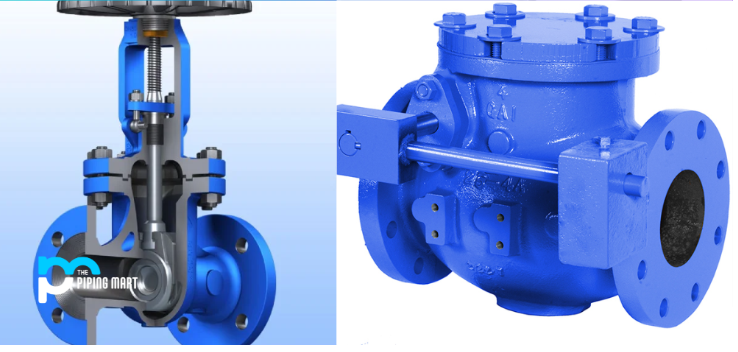Gate valves and check valves serve distinct purposes in industrial piping systems, each offering unique benefits depending on the application. This article reviews each of these valves and compares the features of a gate valve vs a check valve.
What is a Gate Valve?
Gate valves are common in piping systems to control the flow of liquids and gasses. They belong to the family of linear motion valves that control the flow of fluid by raising or lowering a gate-like disc. A typical gate valve provides a tight seal when shut and also provides unrestricted flow when in the fully open position. Depending on the type of material in use, gate valves can serve in low-temperature, low-pressure systems and high-temperature, high pressure applications.
Array of Gate Valves
Advantages of Gate Valves
The use of gate valves provides several advantages in an application.
- Because gate valves provide minimal obstruction to flow, the pressure drop across the valve is insignificant.
- They offer a tight seal when shut-off, thus are suitable for high-pressure applications or when a tight shutoff is necessary.
- They offer a simple design, which makes manufacturing and maintenance straightforward. Gate valve designs also provide options, such as having a rising or non-rising stem, to suit the demands of certain applications.
- A gate valve can serve in ring network pipelines where fluid flow is bi-directional.
- Unique types, such as knife gate valves, can easily handle slurry or any fluids having significant amounts of solids.
Disadvantages of Gate Valves
- Performs poorly in throttling applications as there is no linear relationship between the disc position and fluid flow rate.
- Gate valve has slower response time vs a check valve because of the travel distance between the close and open position.
- Occupies more installation space, especially in rising-stem deployments.
What is a Check Valve?
Check valves, or non-return valves, are designed to allow fluid flow in only one direction, thus preventing backflow. Their automatic operation makes them essential for protecting equipment and maintaining the efficiency of various systems.
How Does a Check Valve Work?
Generally, the deployment of check valves is in applications where the occurrence of backflow is not desirable. To ensure unidirectional flow, these valves utilize discs that automatically provide a positive seal. These discs could be in different forms such as a flap, piston, and ball, which correlates to swing, lift, and ball check valves respectively. In each of these check valve designs, the disc automatically opens to allow fluid flow after attaining a particular pressure. The fluid pressure keeps the valve in the open direction as long as it remains at or above the preset value. However, if there is a drop in pressure, or a backflow, the valve closes by the aid of a return mechanism, which could be in the form of a return spring, gravity, etc. Therefore, check valves provide a self-reliant system that do not require human intervention to operate.
Industrial Check Valve
Advantages of Check Valves
- A check valve has a more compact design vs a gate valve, although both valves have a simple design. This allows for easy installation and maintenance.
- Check valves operate automatically in response to fluid flow, so there is no need for an external control mechanism.
- Because of the quick response of check valves to changes in fluid flow, they are ideal for protection of upstream equipment like compressors and pumps from backflow.
- They are versatile as applications cut across liquid and gas flow control.
Disadvantages of Check Valves
- Rapid closure of check valves can cause water hammer, a pressure surge that can damage pipes and equipment.
- Offers limited control over fluid flow so can serve only in certain applications.
Difference Between Gate Valve vs Check Valve
Gate valves and check valves serve different purposes in fluid control systems. While gate valves are primarily used for starting and stopping the flow, check valves serve to prevent backflow. The following sections highlight some of these differences.
Operational Differences
| Gate Valves | Check Valves |
| Operates either manually or automatically to fully allow or completely shut out flow. Could permit bi-directional flow but not suitable for metering flow. | Design is for automatic operation for flow in only one direction. |
Applications
| Gate Valves | Check Valves |
| Suitable for applications requiring no obstruction on the flow path. For example, water distribution systems, oil pipelines, and chemical processing plants. | Ideal for systems where backflow could damage or reduce efficiency. Instances include pump systems, condensate lines, and fuel systems. |
Pressure Drop
| Gate Valves | Check Valves |
| Pressure drop across gate valves varies according to the type. | Pressure drop across check valves varies according to the type. |
Installation Space
| Gate Valves | Check Valves |
| Generally requires a lot more installation space. However, non-rising stem gate valves offer a relatively compact design. | Can easily fit into tight spaces because of their compact design. |
Choosing Between Gate Valve vs Check Valve
Although gate and check valves differ, some scenarios exist where they could be interchanged or complemented. For example, in an emergency shutdown, an automatic gate valve can isolate the system from pressure while a check valve acting in series prevents backflow. As a result, it is necessary to deploy these valves accurately in line with operating conditions. At QRC, our team of knowledgeable professionals is available to help you in making the decisions that make your system efficient and cost-effective. Contact us today for your valve solutions.


Recent Comments